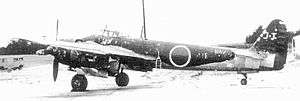Nakajima J5N
| J5N | |
|---|---|
 | |
| Nakajima J5N1 Tenrai | |
| Role | Interceptor |
| Manufacturer | Nakajima Aircraft Company |
| Designer | Katsuji Nakamura, Kazuo Ohno |
| First flight | July, 1944 |
| Primary user | Imperial Japanese Navy Air Service |
| Number built | 6 |
|
| |
The Nakajima J5N was an abandoned Japanese prototype fighter aircraft of the World War II era. J5N was developed as twin-engine interceptor for countering attacks by Boeing B-29 Superfortress.[1]
Design and development
During the spring of 1943, the JNAF issued an 18-Shi specification for a single-seat twin-engine interceptor capable of reaching a top speed of 666 km/h (414 mph) at 6,000 m (19,690 ft). Nakajima submitted a proposal based on the earlier J1N1 Gekko three-seat night fighter, although this new aircraft – designated J5N1 – was slightly smaller. The layout of the J5N was similar to the J1N: a low set wing on which were mounted the two powerplants, 1,484 kW (1,990 hp) Nakajima Homare 21 18-cylinder air-cooled radial engines, with a long fuselage ending in a conventional tail arrangement. For maximum utilization of the power from the twin engines, large four-blade propellers were fitted which also featured large spinners (as fitted to the J1N). The main wheels retracted rearwards into the engine nacelles, and the tailwheel was fixed. The cockpit was set above the wing, and featured a starboard-opening canopy. The nose was streamlined to offer the pilot an excellent forward view during landing, takeoff and taxiing.
Armament of the J5N consisted of two 30 mm and two 20 mm cannon, and provision was made for a centreline 250 kg (550 lb) bomb. The J5N was designed to combat the heavily armed U.S. fighters in the Pacific Theatre at that time, and this impressive armament would have done severe damage to these aircraft. To concentrate the firepower, the four cannons were mounted in the nose of the J5N.
Operational history
Impressed with the design, the JNAF authorized the development of the J5N1, assigned the name Tenrai (天雷"Heavenly Thunder"), and six prototypes were requested to be built. Progress was impeded by the failure of the engines to produce their promised power, and by a steady increase in the weight of the airframe as the need to reverse the long-standing policy of giving low priority to armor protection led to a buildup of weight and a drop in performance.[2] The first prototype – lacking its armament – made its first flight July 13, 1944, and was something of a disappointment. The top speed attained was only 597 km/h (371 mph) – far below the specified 666 km/h (414 mph) of the requirement. Despite the other five prototypes also having flown with numerous enhancements, the aircraft never achieved its design speed, and the project was abandoned soon after in February 1945. Four of the six experimental aircraft were lost to accidents.[3]
Variants
- J5N1 : Single-seat interceptor fighter aircraft. Six built.
Specifications (J5N1)
Data from [4]
General characteristics
- Crew: 1 (two aircraft completed as two-seaters)
- Length: 11.46 m (37 ft 7 in)
- Wingspan: 14.4 m (47 ft 3 in)
- Height: 2.38 m (7 ft 10 in)
- Gross weight: 7,300 kg (16,094 lb)
- Powerplant: 2 × Nakajima Homare 21 18-cyl. air-cooled radial piston engines, 1,480 kW (1,990 hp) each
Performance
- Maximum speed: 596 km/h; 371 mph (322 kn) achieved
- (666.7 km/h (360 kn) at 6,000 m (19,685 ft) specification)
- Rate of climb: 15 m/s (3,000 ft/min)
- Wing loading: 230 kg/m2 (47 lb/sq ft)
- Power/mass: 0.40 kW/kg (0.24 hp/lb)
Armament
- Guns:
- 2 × 30 mm cannon
- and/or
- Bombs: 1 × 250 kg (551 lb) bomb
See also
- Aircraft of comparable role, configuration and era
References
Notes
Bibliography
- Berliner, Don. Surviving Fighter Aircraft of World War Two: Fighters. London: Pen & Sword Aviation, 2011. ISBN 978-1-8488-4265-6.
- Francillon, Rene J. Japanese Aircraft of the Pacific War (1st ed.). London: Putnam & Company Ltd., 1970. ISBN 0-370-00033-1.
- Green, William. Warplanes of the Second World War, Volume Three: Fighters. London: Macdonald & Co.(Publishers) Ltd., 1961. ISBN 978-0-356-01447-0.
- Shigeru, Nohara.Photo Book Japanese Fighter(in Japanese). Kojinsha, 2000. ISBN 978-4-7698-1493-1.
- Townend, David R. Thunderbolt & Lightning. Markham: AeroFile Publications, 2008, ISBN 978-0-9732020-2-1.
External links
| Wikimedia Commons has media related to Nakajima J5N Tenrai. |
| ||||||||||||||||||||||||||||||||||||||||||||||||||||||||||
| ||||||